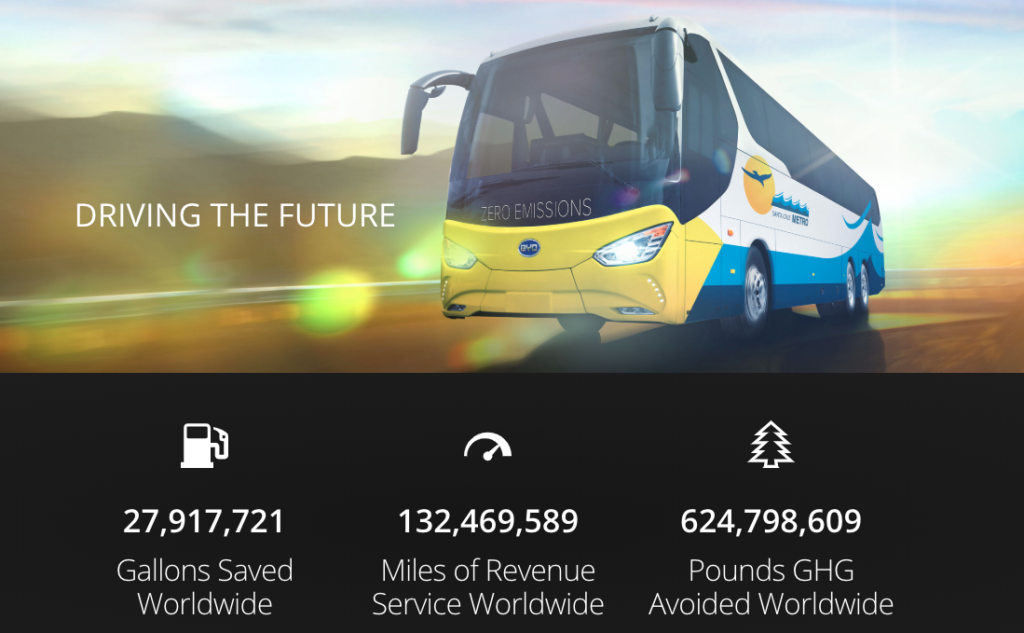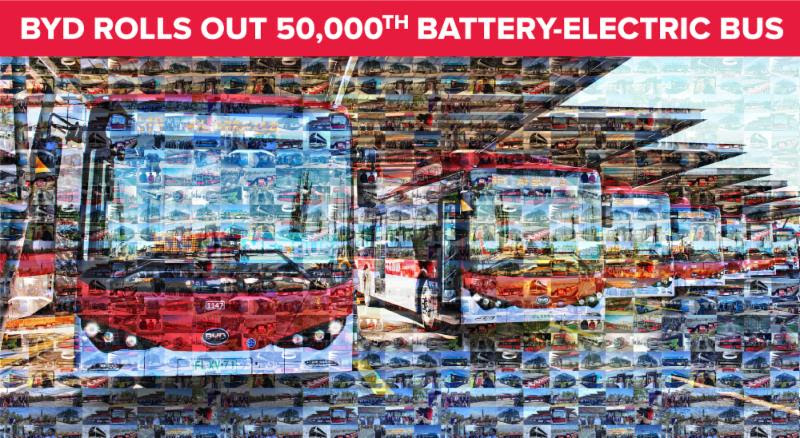
Have you seen fully electric buses in your town yet? If not, keep an eye out. BYD this month reached a new milestone with the completion of its 50,000th fully electric bus. Transit and fleet operators worldwide are noticing the cost savings, quiet rides, and lack of tailpipe pollution that cities enjoy with electric vehicles from BYD, Proterra Inc., and others. What’s more, the agencies burnish their image by showcasing their commitment to clean air, new technology, and a healthier future.
According to the U.S. Department of Transportation, operating 50,000 electric buses is equivalent to taking 1.35 million cars off the road and eliminating 84.5 million tons of C02 over 12 years. And emissions by electric vehicles are 40% lower than internal combustion engines—even when using electricity generated by coal power plants according to Bloomberg NEF (and they will get even cleaner over time as old coal plants retire and are replaced with cleaner natural gas and renewables).
Early success in the transit market is apparent by a wave of electric bus announcements in at least 30 states and the District of Columbia. Recognizing that governmental budget cycles sometimes focus more on upfront costs as compared to lifetime cost, many of these purchases benefit from local, state, and federal funds.
California Incentives
California, in particular, offers substantial incentives through its Hybrid and Zero-Emission Truck and Bus Voucher Incentive Project (HVIP) and the Low Carbon Fuel Standard (LCFS) program. HVIP lowers the up-front purchase price, and sample offerings (as of October 8, 2018) include $120,000 for a BYD 35’ transit bus carrying a 350 kWh battery, $90,000 for a Gillig 29’ low-floor transit bus carrying a 296 kWh battery, and $150,000 for a Proterra 40’ transit bus carrying a 126 kWh battery. Revenue from the state’s LCFS significantly offset the cost of electricity. The result is a lower total cost of ownership for electrics as compared to diesel powered vehicles. According to Bloomberg New Energy Finance, a typical bus with a 250kWh battery charging slowly once per day at the depot and operating around 166km/day has a lower total cost of ownership (TCO) ($0.99/km) than diesel ($1.05/km) or CNG ($1.19/km).
Federal Incentives
At the federal level, the Federal Transit Administration administers the “Low or No Emission (Low-No) Vehicle Program.” The Low or No Emission competitive program provides funding to state and local governmental authorities for the purchase or lease of zero-emission and low-emission transit buses as well as acquisition, construction, and leasing of required supporting facilities. Under the FAST Act, $55 million per year is available until fiscal year 2020. Eligible projects include:
- purchasing or leasing low- or no-emission buses;
- acquiring low- or no-emission buses with a leased power source;
- constructing or leasing facilities and related equipment (including intelligent technology and software) for low- or no-emission buses;
- constructing new public transportation facilities to accommodate low- or no-emission buses; and
- rehabilitating or improving existing public transportation facilities to accommodate low- or no-emission buses.
Case Study #1: Chicago Transit Agency
The Chicago Transit Agency (CTA) is an example of a large metropolitan bus operator that is an early adopter: the CTA has been operating two New Flyer e-buses for three years. Each bus carries 300 kWh of battery storage, which provides about a 100 mile range. The buses charge using 100 kW chargers. At that rate, each bus takes about three hours to charge to 80 percent if starting at empty.
Each of the CTA buses today serves the AM and PM rush periods, and they cover 120 to 140 miles per day. Because the routes require more energy than provided by a single charge, each bus is dispatched for about six hours in the morning, during which it covers 50 to 60 miles. The bus then returns to the depot to charge at mid-day for a few hours before returning to service for the afternoon rush, during which it covers 70 to 80 miles over about an 8 hour period. The CTA expects to purchase at least 20 more e-buses in the next few years along with five fast chargers and an option for an additional 25 e-buses.
Case Study #2: State of Georgia
The state of Georgia is also making a significant investment in electric buses through its share of the Volkswagen consent decree arising from the company’s diesel emissions litigation. States are permitted to invest in ten different mitigation actions including large trucks, eligible buses, port cargo handling equipment, and EV charging infrastructure. Georgia’s Beneficiary Mitigation Plan allocates 100% of its $63 million to electric buses at Hartsfield-Jackson Atlanta International Airport and the State Road and Tollway Authority’s (SRTA) Xpress system, both of which are nonattainment areas for the ozone NAAQS standard (the SRTA buses will be a mix of clean diesel and full-electric).
Conclusion
For more information about electric vehicles and electric vehicle charging, please contact me. I also invite you to subscribe to receive future posts via email, view my other posts, and follow me on Twitter.

